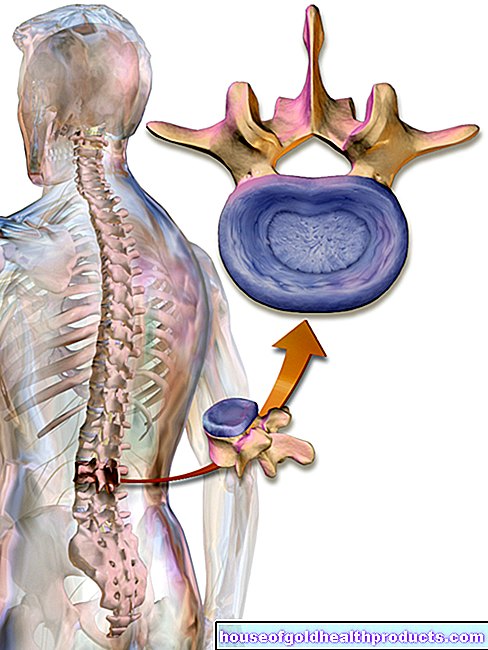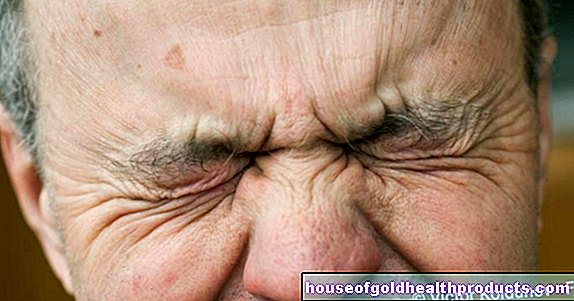Diazepam
Updated on All content is checked by medical journalists.Diazepam is currently one of the most frequently prescribed sleeping pills (hypnotics). In addition, the active ingredient is used as a tranquilizer (sedative), anticonvulsant (anti-epileptic), anti-anxiety agent (anxiolytic) and for muscle relaxation (muscle relaxant). Diazepam requires a prescription and should only be taken as directed by a doctor. Here you can read everything you need to know about diazepam!
This is how diazepam works
Diazepam is a drug from the benzodiazepine group and as such has an anxiolytic, calming, muscle-relaxing and antispasmodic effect.
The active ingredient influences the nerve cells in the brain stem and the limbic system - a functional unit of the brain that is essentially responsible for a person's wellbeing. Diazepam increases the inhibitory effect of a transmitter substance (gamma-aminobutyric acid) and thereby reduces the excitability of the cells.
The inhibitory effect in the area of the nerve cells in the brain stem has a muscle-relaxing, calming and sleep-promoting effect. The dampening of the limbic system reduces the influence of external and internal stimuli and their processing and creates a distance to external and internal experiences.
This relieves anxiety and tension and provides emotional calming. At the same time, mental impairments have less of an impact on the autonomic nervous system, which controls vital functions such as heartbeat, blood pressure, breathing and digestion.
Uptake, breakdown and excretion
Diazepam, which is taken up by mouth, is well absorbed into the blood through the gastrointestinal tract, with which it reaches the brain and quickly takes effect. The active ingredient is broken down in the liver.
This creates degradation products that are also effective (active metabolites) and are slowly excreted in the urine. The half-life of diazepam - i.e. the period of time after which about half of the active ingredient is excreted - is approximately 48 hours.
To ensure that the active ingredient does not accumulate in the body, the dosage prescribed by the doctor must be strictly adhered to!
When is diazepam used?
The areas of application (indications) of diazepam are:
- States of tension, excitement and anxiety
- for premedication (preparation for anesthesia) before diagnostic or surgical interventions
- Conditions with increased muscle tension (e.g. status epilepticus = persistent epileptic seizure)
- Trouble sleeping
This is how diazepam is used
Diazepam tablets and drops are taken with a glass of water either before a meal or some time after. Diazepam suppositories are inserted into the anus, rectal tubes are emptied in the anus according to the product information.
The doctor determines the diazepam dosage and duration of use individually. In principle, the dose should be kept as low as possible and the duration of the treatment as short as possible. As a rule, diazepam should not be used for more than four weeks.
It is taken in the evening half an hour before going to bed. The drug should not be taken on a full stomach, otherwise the onset of action will be delayed. In addition, side effects such as tiredness and poor concentration the next morning can be avoided.
To stop treatment after prolonged use (more than two weeks), the drug should not be stopped suddenly. Instead, after consulting your doctor, the dosage should be gradually reduced ("tapering off").
What side effects does diazepam have?
Side effects are dose-dependent and occur mainly at the beginning of treatment. The most important adverse effects include daytime sleepiness and drowsiness with impaired alertness and ability to react.
Other possible side effects include drowsiness, dizziness, confusion, gait and movement disorders, headaches and temporary memory lapses.
In patients with a pre-existing depressive illness, diazepam can aggravate depressive moods. Sensory disturbances and a reversal of the diazepam effects are also possible. A reversal of the effects manifests itself in short-term states of excitement, fear, sleep disorders, fits of anger, muscle cramps and an increased tendency to suicide.
With prolonged or repeated use of diazepam, its effectiveness may decrease. If high doses are taken for a long time, temporary disturbances such as slow or slurred speech, visual disturbances as well as movement and gait insecurity are possible.
What should be considered when using diazepam?
Contraindications
Benzodiazepines such as diazepam must not be used in the case of known hypersensitivity to this group of active ingredients and also not in the case of severe pathological muscle weakness (myasthenia gravis).
In certain other cases, use is only recommended if absolutely necessary and after careful risk-benefit assessment, for example in the case of acute poisoning with alcohol or other central depressant substances, severe liver damage, severe respiratory failure and narrow-angle glaucoma (a form of glaucoma).
Interactions
Grapefruit juice increases the absorption of diazepam in the intestine and reduces its breakdown.
Under no circumstances should Diazepam be taken with alcohol, as this can alter and intensify the effects of the medication in an unpredictable way.
Simultaneous use of diazepam and other central depressant drugs (such as sleeping pills, some pain relievers, anesthetics, etc.) increases the drowsy and respiratory depressant effect.
The effect of drugs that reduce muscle tension (muscle relaxants) can be increased by diazepam. The breakdown of diazepam can be accelerated by phenobarbital and phenytoin (agents against epilepsy), which shortens its duration of action.
Interactions are also possible with other drugs, for example with certain antibiotics, antidepressants and beta blockers (cardiovascular drugs).
If you receive any new medication in addition to diazepam (including non-prescription drugs), inform your doctor to be on the safe side.
Diazepam withdrawal symptoms
Long-term use of diazepam can lead to emotional and physical dependence. When the therapy is ended, withdrawal symptoms such as sleep disorders, increased dreaming, states of fear and tension as well as inner restlessness can occur.
To avoid withdrawal symptoms, the dose should be gradually reduced when the patient is discontinued. A required dose increase can be a sign of addiction. The drug should then be discontinued.
Children and adolescents
If indicated, diazepam can be given to infants as early as six months of age.
pregnancy and breast feeding period
Studies of several thousand pregnancies under diazepam therapy did not reveal any evidence of malformations of the embryo. Nevertheless, to be on the safe side, diazepam should not be used during pregnancy.
Patients on diazepam therapy who wish to become pregnant or suspect pregnancy should inform their doctor immediately. He can then decide whether the therapy can be continued or whether it has to be discontinued.
Single doses during breastfeeding (e.g. for acute anti-epileptic treatment) are possible. In this case, no breastfeeding break is necessary. In the case of continuous administration, attention must be paid to the side effects of the infant such as sedation, poor drinking and weight loss.
This is how you get drugs with the active ingredient diazepam
In Germany, Austria and Switzerland, preparations with diazepam require a prescription, so they are only available with a prescription in pharmacies.
Diazepam suppositories are only available as finished preparations in Germany, but not in Austria or Switzerland.
How long has diazepam been known?
Diazepam was developed by the pharmacist and chemist Leo Henry Sternbach in New Jersey when he was researching the chemical group of benzodiazepines. Before that, he had already succeeded in 1957 in producing substances in his laboratory that turned out to be highly effective drugs for calming down.
What else you should know about diazepam
The calming and sleep-promoting effect also reduces the ability to concentrate and react in the morning after taking it in the evening. The muscle-relaxing effect can also lead to limited muscle function.
Therefore, your ability to drive and work with machines may be impaired during treatment with diazepam.
Tags: menshealth palliative medicine parasites





























